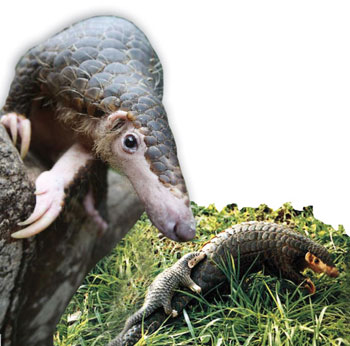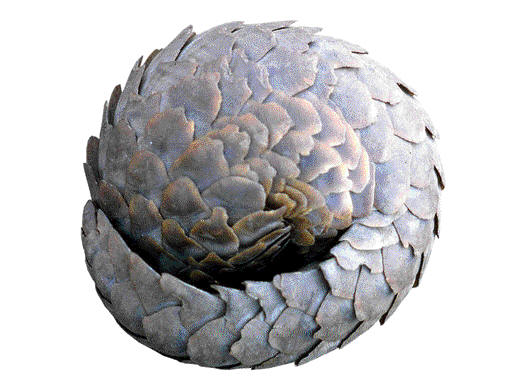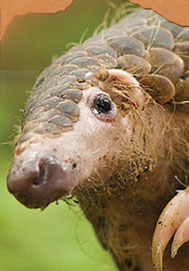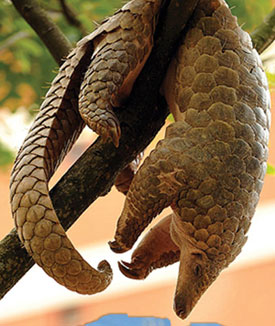|

For this week's special feature, we're introducing the Pangolin to
you! Like the anteater, the pangolin also is an insectivore and can be
found right here in Sri Lanka too. Learn how these animals have adapted
to their strange ways of life and also the differences between them and
the anteaters.
 The
pangolins are commonly referred to as scaly anteaters, even though they
have nothing in common with the anteaters, except eating habits. The
name "pangolin" is derived from the Malay word pangolin (something that
rolls up). The
pangolins are commonly referred to as scaly anteaters, even though they
have nothing in common with the anteaters, except eating habits. The
name "pangolin" is derived from the Malay word pangolin (something that
rolls up).

They are found in tropical regions of Africa and Asia, and in Sri
Lanka. In Sinhala it is called the kebellawa and in Tamil, allangu. The
pangolin is found in many other Asian countries as well. It is related
to the anteater in Africa and the armadillo in South America.The
pangolin found in Sri Lanka is more commonly known as the Indian
pangolin (Manis crassicaudata). In our country this animal is strictly
terrestrial; that means it dwells only on the ground. However, some of
the other species are known to climb trees as well. The pangolins are
found in many parts of the low country, going up to about 3,500 feet.
They can be seen in the wilds in Anuradhapura, Polonnaruwa and Badulla
districts, but nowhere in their habitats are they found in large
numbers.
The Indian pangolin is one of the few species that will climb trees,
however it is not strictly arboreal (tree dwelling) and will also dig
burrows. This species of pangolin, lives mostly alone except during the
mating and breeding season, when adult male and female pangolins are
found in the same burrow.
Unlike most mammals, the pangolin is identified by the large
overlapping scales on its body, which it uses as a protective
coat/shield. These scales are considered as modifications of hair or
spines flattened into scales. The underside of the body has some coarse,
bristle-like hair which can be seen in-between the scales. Like all
pangolins the Indian pangolin too has large armoured scales and will
quickly curl up into a ball, with its tail covering its head for
protection, when it feels threatened.
 When
pangolins roll up into a ball for defense they exhibit enormous muscular
power that defies any ordinary attempt to unroll them. Of course it is
probable that stronger carnivores can prey upon them. They also protect
themselves with their anal glands which emit a foul smelling, yellow
fluid, like in skunks for additional defense against enemies. When
pangolins roll up into a ball for defense they exhibit enormous muscular
power that defies any ordinary attempt to unroll them. Of course it is
probable that stronger carnivores can prey upon them. They also protect
themselves with their anal glands which emit a foul smelling, yellow
fluid, like in skunks for additional defense against enemies.
The Indian pangolin grows to a weight of 17-19 lbs (8-9 kilograms)
and its head and body length reaches 2.0-2.2 ft (60-65 centimetres) with
the armoured tail adding 1.5-1.8 ft (45-55 centimetres) to the overall
length. The skin is brownish in colour, while the scales appear to be
either brown or yellowish, but usually are kept in tune with their
surroundings to stay unnoticed, much like that of the chameleons.The
pangolin has a large tail, which helps it to balance when moving about.
In fact it elevates its tail when it moves about. It has limbs with five
clawed digits and its hind leg is longer and stouter than its fore leg.
These animals walk very slowly and arch their backs completely, walking
in a hunched manner, practically on their hind feet with the tail used
to maintain the balance.

However, when needed they can walk as fast as a human. When they
walk, it looks as if they are walking on their knuckles with the soles
of the feet turned outwards. This is because of the positioning of the
claws. They are also good swimmers.
With a thick tail and an oblong or conical skull, the pangolin is one
of the strangest creatures that can be seen today. Pangolins are
nocturnal in habits, spending the day in their burrows, which are long
tunnels ending into a large chamber. Burrows may be fairly deep (6 m) in
loose soil. The entrance of the burrow is closed with earth when the
animal is inside. They do not have good hearing or eyesight; instead
they rely on their sense of smell to locate the nests of ants and
termites. They have three main claws that allow them to dig through
tough soil. They feed mainly on eggs, young ones and adults of termites
and ants by digging the termite or ant nests.
 Before
digging the termite or ant nests, they utilise their sense organs and
smell rapidly around the area to select the most suitable spot to start
with, and they feed quickly by extending a protrusible, (able to extend
quickly) long, thin, copiously (plentifully) lubricated tongue into the
galleries of nests. They enjoy eating eggs more than the
adults.Pangolins are particularly attracted by the leaf nests of large
red ants, which hold the swarms of adults and their eggs. Before
digging the termite or ant nests, they utilise their sense organs and
smell rapidly around the area to select the most suitable spot to start
with, and they feed quickly by extending a protrusible, (able to extend
quickly) long, thin, copiously (plentifully) lubricated tongue into the
galleries of nests. They enjoy eating eggs more than the
adults.Pangolins are particularly attracted by the leaf nests of large
red ants, which hold the swarms of adults and their eggs.
A close correlation exists between the range of distribution of M.
pentadactyl and the abundance of termite species, Coptotermes formosanus.
In captivity, pangolins are fed with milk, meat and eggs. Due to the
absence of teeth, food is directly taken into the stomach and grinded
with the help of strong musculature and pebbles collected during
feeding.Gestation (pregnancy) times for the Indian pangolin are roughly
65-75 days, with the average litter size being two or just one.Births
can occur at any season and time throughout the year with births having
been recorded in January, March, July and November. Females give birth
to one or two young at a time. Weight at birth is 8.2-8.6 oz (230-240
g). Scales of young are soft, with fully functioning eyes and legs.

At about one month of age, young are carried on the dorsal (back)
base of the mother's tail when foraging (looking for food). At about
three months of age the young are (believed to be) weaned. Sexual
maturity and lifespan in the wild for Indian pangolins are unknown.Other
information, such as rearing habits for the Indian pangolin is also
unknown.Currently the Indian pangolin is listed as near-threatened by
the International Union for the Conservation of Nature and Natural
Resources (IUCN) and their survival depends on further conservation. So,
whenever you come across a pangolin, do not kill it or harm it in
anyway.
Call the wildlife authorities and hand over the animal because it's a
threatened species and needs to be conserved. -Shalindi PERERA
|

